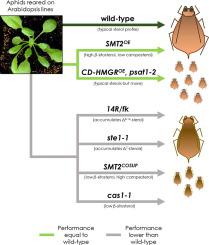当前位置:
X-MOL 学术
›
J. Insect Physiol.
›
论文详情
Our official English website, www.x-mol.net, welcomes your feedback! (Note: you will need to create a separate account there.)
Aphid growth and reproduction on plants with altered sterol profiles: Novel insights using Arabidopsis mutant and overexpression lines.
Journal of Insect Physiology ( IF 2.2 ) Pub Date : 2020-04-07 , DOI: 10.1016/j.jinsphys.2020.104054 Ivy W Chen 1 , Robert J Grebenok 2 , Hubert Schaller 3 , Keyan Zhu-Salzman 1 , Spencer T Behmer 4
Journal of Insect Physiology ( IF 2.2 ) Pub Date : 2020-04-07 , DOI: 10.1016/j.jinsphys.2020.104054 Ivy W Chen 1 , Robert J Grebenok 2 , Hubert Schaller 3 , Keyan Zhu-Salzman 1 , Spencer T Behmer 4
Affiliation

|
Sterols are essential membrane components and are critical for many physiological processes in all eukaryotes. Insects and other arthropods are sterol auxotrophs that typically rely on a dietary source of sterols. Herbivorous insects generally obtain sterols from plants and then metabolize them into cholesterol, the dominant sterol in most insects. However, there is significant variation in phytosterol structure, and not all phytosterols are equally suitable for insects. In the current study, we used seven Arabidopsis thaliana lines that display altered sterol profiles due to mutations in the sterol biosynthetic pathway or to overexpression of key enzymes of the pathway, and investigated how plant sterol profiles affected green peach aphid (Myzus persicae) growth and reproduction. We also characterized the sterol profile of aphids reared on these Arabidopsis genotypes. Aphids on two mutant lines (14R/fk and ste1-1) that accumulated biosynthetic sterol intermediates (Δ8,14-sterols, and Δ7-sterols, respectively) all showed significantly reduced growth and reproduction. Aphids on SMT2COSUP plants (which have decreased β-sitosterol but increased campesterol) also displayed significantly reduced growth and reproduction. However, aphids on SMT2OE plants (which have increased β-sitosterol but decreased campesterol) performed similarly to aphids on wild-type plants. Finally, Arabidopsis plants that had an overproduction of sterols (CD-HMGROE) or decreased sterol esters (psat1-2) had no impact on aphid performance. Two noteworthy results come from the aphid sterol profile study. First, β-sitosterol, cholesterol and stigmasterol were recovered in all aphids. Second, we did not detect Δ8,14-sterols in aphids reared on 14R/fk plants. We discuss the implications of our findings, including how aphid sterol content does not appear to reflect plant leaf sterol profiles. We also discuss the potential of modifying plant sterol profiles to control insect herbivore pests, including aphids.
中文翻译:

固醇谱改变的植物上的蚜虫生长和繁殖:利用拟南芥突变体和过表达系的新见解。
甾醇是必不可少的膜成分,对于所有真核生物的许多生理过程都至关重要。昆虫和其他节肢动物是固醇营养缺陷型,通常依赖于饮食中的固醇来源。食草昆虫通常从植物中获得固醇,然后将其代谢为胆固醇,而胆固醇是大多数昆虫中的主要固醇。但是,植物甾醇的结构存在显着差异,并非所有植物甾醇都同样适用于昆虫。在当前的研究中,我们使用了七个拟南芥品系,这些品系由于固醇生物合成途径的突变或该途径关键酶的过度表达而显示出固醇特征的改变,并研究了植物固醇特征如何影响桃蚜(Myzus persicae)的生长和再生产。我们还表征了在这些拟南芥基因型上饲养的蚜虫的甾醇谱。积累了生物合成固醇中间体(分别为Δ8,14-固醇和Δ7-固醇)的两个突变系(14R / fk和ste1-1)上的蚜虫均显示出生长和繁殖显着降低。SMT2COSUP植物上的蚜虫(β-谷甾醇减少而菜油甾醇增加)也显示出生长和繁殖明显减少。然而,SMT2OE植物上的蚜虫(β-谷固醇增加而菜油甾醇减少)的表现与野生型植物上的蚜虫相似。最后,具有过量固醇(CD-HMGROE)或固醇酯(psat1-2)减少的拟南芥植物对蚜虫的生长性能没有影响。蚜虫固醇谱研究有两个值得注意的结果。首先是β-谷固醇 在所有蚜虫中都回收了胆固醇和豆甾醇。其次,我们未在14R / fk植物上培育的蚜虫中检测到Δ8,14-固醇。我们讨论了我们发现的含义,包括蚜虫固醇含量如何似乎没有反映出植物叶片固醇特征。我们还讨论了修饰植物固醇谱以控制昆虫食草动物害虫(包括蚜虫)的潜力。
更新日期:2020-04-21
中文翻译:

固醇谱改变的植物上的蚜虫生长和繁殖:利用拟南芥突变体和过表达系的新见解。
甾醇是必不可少的膜成分,对于所有真核生物的许多生理过程都至关重要。昆虫和其他节肢动物是固醇营养缺陷型,通常依赖于饮食中的固醇来源。食草昆虫通常从植物中获得固醇,然后将其代谢为胆固醇,而胆固醇是大多数昆虫中的主要固醇。但是,植物甾醇的结构存在显着差异,并非所有植物甾醇都同样适用于昆虫。在当前的研究中,我们使用了七个拟南芥品系,这些品系由于固醇生物合成途径的突变或该途径关键酶的过度表达而显示出固醇特征的改变,并研究了植物固醇特征如何影响桃蚜(Myzus persicae)的生长和再生产。我们还表征了在这些拟南芥基因型上饲养的蚜虫的甾醇谱。积累了生物合成固醇中间体(分别为Δ8,14-固醇和Δ7-固醇)的两个突变系(14R / fk和ste1-1)上的蚜虫均显示出生长和繁殖显着降低。SMT2COSUP植物上的蚜虫(β-谷甾醇减少而菜油甾醇增加)也显示出生长和繁殖明显减少。然而,SMT2OE植物上的蚜虫(β-谷固醇增加而菜油甾醇减少)的表现与野生型植物上的蚜虫相似。最后,具有过量固醇(CD-HMGROE)或固醇酯(psat1-2)减少的拟南芥植物对蚜虫的生长性能没有影响。蚜虫固醇谱研究有两个值得注意的结果。首先是β-谷固醇 在所有蚜虫中都回收了胆固醇和豆甾醇。其次,我们未在14R / fk植物上培育的蚜虫中检测到Δ8,14-固醇。我们讨论了我们发现的含义,包括蚜虫固醇含量如何似乎没有反映出植物叶片固醇特征。我们还讨论了修饰植物固醇谱以控制昆虫食草动物害虫(包括蚜虫)的潜力。



























 京公网安备 11010802027423号
京公网安备 11010802027423号